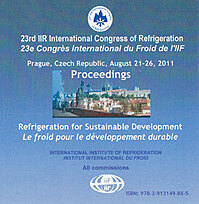
Document IIF
Validation de la chaîne du froid pour la chimiothérapie intraveineuse ambulatoire : un exemple du "dernier kilomètre".
Cold chain validation for home-based intravenous chemotherapy: a last mile example.
Numéro : pap. ID: 731
Auteurs : BENIZRI F., BONAN B., MITTAINE-MARZAC B., et al.
Résumé
Home-based intravenous chemotherapy requires cold chain validation to ensure thermo-sensitive products are maintain at the correct temperature from production unit of pharmacy department to patient’s home. The aim of this study is, firstly, to validate thermal performances of packaging and, secondly, to monitor the cold chain in real conditions with traceability to the last mile. Thermal performances of packagings were tested, by a COFRAC accredited laboratory (Cemafroid) according to the NF S99700 AFNOR standard. Conditions of validation were defined in the worst-case conditions. On 22 configurations of packaging provided by 3 suppliers and tested in climatic chamber, 41 % (9/22) are not compliant. In real conditions, 2.5% (7/281) of cases of non compliant have been observed between October 2009 and December 2010. None of cold chain failure was explained by thermal performance of packaging. This experiment, with example of home-based chemotherapy, represents a novel approach in the hospital world of validation of the cold chain with a perfect example of last mile.
Documents disponibles
Format PDF
Pages : 8 p.
Disponible
Prix public
20 €
Prix membre*
Gratuit
* meilleur tarif applicable selon le type d'adhésion (voir le détail des avantages des adhésions individuelles et collectives)
Détails
- Titre original : Cold chain validation for home-based intravenous chemotherapy: a last mile example.
- Identifiant de la fiche : 30002150
- Langues : Anglais
- Source : Proceedings of the 23rd IIR International Congress of Refrigeration: Prague, Czech Republic, August 21-26, 2011. Overarching theme: Refrigeration for Sustainable Development.
- Date d'édition : 21/08/2011
Liens
Voir d'autres communications du même compte rendu (569)
Voir le compte rendu de la conférence
Indexation
-
Thèmes :
Génie pharmaceutique;
Conteneurs et emballages - Mots-clés : Chaîne du froid; Tracabilité; Performance; Industrie pharmaceutique; Experimentation; Emballage
-
Securing of cooling steps before packaging: exa...
- Auteurs : BENIZRI F., DERENS E., DELAHAYE A., et al.
- Date : 21/08/2011
- Langues : Anglais
- Source : Proceedings of the 23rd IIR International Congress of Refrigeration: Prague, Czech Republic, August 21-26, 2011. Overarching theme: Refrigeration for Sustainable Development.
- Formats : PDF
Voir la fiche
-
Evaluación de riesgos en un almacén logístico d...
- Auteurs : MUÑOZ-ANTÓN J., GONZÁLEZ-MARIÑAS A., FERNÁNDEZ BENÍTEZ J. A., et al.
- Date : 03/05/2016
- Langues : Espagnol
- Source : CYTEF 2016. VIII Congreso Ibérico y VI Congreso Iberoamericano de las Ciencias y Técnicas del Frío, Coimbra-Portugal, 3-6 mayo, 2016.
- Formats : PDF
Voir la fiche
-
Evaluation of pharmacy cold chain.
- Auteurs : BONED M., CAVALIER G.
- Date : 02/04/2013
- Langues : Anglais
- Source : 2nd IIR International Conference on Sustainability and the Cold Chain. Proceedings: Paris, France, April 2-4, 2013.
- Formats : PDF
Voir la fiche
-
Measurement of temperature homogeneity in equip...
- Auteurs : CAVALIER G., BOUDET N., BONED M.
- Date : 16/08/2015
- Langues : Anglais
- Source : Proceedings of the 24th IIR International Congress of Refrigeration: Yokohama, Japan, August 16-22, 2015.
- Formats : PDF
Voir la fiche
-
Pharmaceuticals cold chain challenges.
- Auteurs : CAVALIER G.
- Date : 16/08/2015
- Langues : Anglais
- Source : Proceedings of the 24th IIR International Congress of Refrigeration: Yokohama, Japan, August 16-22, 2015.
- Formats : PDF
Voir la fiche
